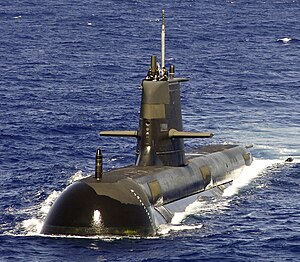 HMAS Rankin, sixth submarine of the Collins class, underway in 2006
| |
| Class overview | |
|---|---|
| Builders | |
| Operators | |
| Preceded by | Oberon class |
| Succeeded by |
|
| Cost | |
| Built | 14 February 1990 – 18 March 2003 |
| In commission | 27 July 1996 – present |
| Completed | 6 |
| Active | 6 |
| General characteristics | |
| Type | Diesel-electric submarine |
| Displacement |
|
| Length | 77.42 m (254.0 ft) |
| Beam | 7.8 m (26 ft) |
| Draught | 7 m (23 ft) at waterline |
| Installed power | 3 × Garden Island-Hedemora HV V18b/15Ub (VB210) 18-cylinder diesel motors, 3 × Jeumont-Schneider generators (1,400 kW, 440-volt DC) |
| Propulsion |
|
| Speed |
|
| Range |
|
| Endurance | 70 days |
| Test depth | Over 180 m (590 ft) – actual depth classified |
| Complement |
|
| Sensors and processing systems |
|
| Electronic warfare & decoys |
|
| Armament | |
The Collins-class submarines are Australian-built diesel-electric submarines operated by the Royal Australian Navy (RAN). The Collins class takes its name from Australian Vice Admiral John Augustine Collins; each of the six submarines is named after significant RAN personnel who distinguished themselves in action during World War II. The six vessels were the first submarines built in Australia, prompting widespread improvements in Australian industry and delivering a sovereign (Australian controlled) sustainment/maintenance capability.
Planning for a new design to replace the RAN's Oberon-class submarines began in the late 1970s and early 1980s. Proposals were received from seven companies; two were selected for a funded study to determine the winning design, which was announced in mid-1987. The submarines, enlarged versions of Swedish shipbuilder Kockums' Västergötland class and originally referred to as the Type 471, were constructed between 1990 and 2003 in South Australia by the Australian Submarine Corporation (ASC).
The submarines have been the subject of many incidents and technical problems since the design phase, including accusations of foul play and bias during the design selection, improper handling of design changes during construction, major capability deficiencies in the first submarines, and ongoing technical problems throughout the early life of the class. These problems have been compounded by the inability of the RAN to retain sufficient personnel to operate the submarines—by 2008, only three could be manned, and between 2009 and 2012, on average two or fewer were fully operational. The resulting negative press has led to a poor public perception of the Collins class. After 20 years of service issues, the boats have finally provided high availability to the RAN since 2016.
The Collins class was expected to be retired about 2026, however, the 2016 Defence White Paper extended this into the 2030s.[2][3] The Collins class life will now be extended and will receive an unplanned capability upgrade, including sonar and communications.[2][3]
The initial replacement for the Collins class was to be a conventionally-powered version of the Barracuda-class SSN proposed by Naval Group of France, dubbed the Attack class. On 15 September 2021, in the face of growing delays and cost increases, the Australian government announced the cancellation of the contract with Naval Group, and that the replacement will be a nuclear-powered submarine fleet made in partnership with the United Kingdom and the United States.[4][5]
- ^ "The AUKUS Nuclear-Powered Submarine Pathway". Australian Department of Defence. Retrieved 14 March 2023.
- ^ a b Department of Defence, 2016 Defence White Paper, pp. 91-92
- ^ a b Greene, Collins Class submarine life to be extended as Defence delays roll-out of new vessels
- ^ Australia to acquire nuclear submarine fleet as part of historic deal with US and UK to counter China's influence ABC News, 16 September 2021. Retrieved 16 September 2021.
- ^ Australia Goes Nuclear: Will Acquire Nuclear-Powered Attack Submarines Overt Defense, 15 September 2021. Retrieved 16 September 2021.